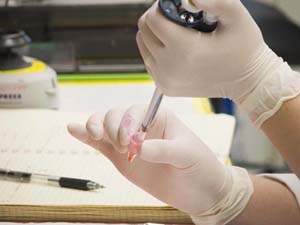The School of Medicine and the College of Arts and Sciences at the University of Alabama at Birmingham now share the faculty, resources and expertise of the Department of Neurobiology, which formerly was only in the School of Medicine.
 The joint department formalizes a collaboration that began in 2009 when UAB created an undergraduate program in neuroscience. Students are admitted through the College and take coursework from School of Medicine faculty.
The joint department formalizes a collaboration that began in 2009 when UAB created an undergraduate program in neuroscience. Students are admitted through the College and take coursework from School of Medicine faculty. Now UAB is positioned to grow the program, says Robert Palazzo, dean of the College of Arts and Sciences.
“The curriculum will become more robust, with cross instruction and team-based courses,” Palazzo said. “When multiple scholars from different backgrounds are providing instruction in the same class it provides a richer experience for the students.”
The neuroscience program is the only one in Alabama, and the aim is to provide students the kind of education they could only receive at an elite private university, said David Sweatt, Ph.D., the Evelyn F. McKnight Chair for Learning and Memory in Aging and chair of the Department of Neurobiology.
“We wanted to look for ways to provide opportunities for students at an affordable price,” Sweatt said. “Our students are phenomenally good. We leveraged outstanding researchers and partnered with undergraduates to provide the kind of college experience most students could only get from Harvard or Stanford, so kids who want to stay in Alabama for their education can stay in Alabama.”
The UAB program gives students experience to do hands-on research funded by the National Institutes of Health, Sweatt said. The Department of Neurobiology receives about $25 million in funding from the National Institutes of Health. “The curriculum is demanding, on par with any in the country, and it makes them successful for the next stage of their career.”
There currently are 78 neuroscience majors; their average grade point average is 3.86 and all of them receive academic scholarships. Minimum requirements are a 30 on the ACT exam and a high school GPA of 3.75, but interest is growing from around the country, according to Carl McFarland, Ph.D., professor of Psychology and co-director of the program with Anne Theibert, Ph.D., associate professor of Neurobiology.
Ray L. Watts, M.D., president of UAB and a renowned neurologist, said neuroscience is an expanding career field, and growing neuroscience is part of UAB’s larger mission of increasing opportunities for students who demonstrate academic excellence in the sciences.
“We have a wealth of excellence in the basic sciences at UAB, and we see it as our mission to expand educational opportunities and nurture students who will help solve the world’s scientific and medical dilemmas,” Watts said. “We hope to expand these types of collaborations in the future.”
The neuroscience program provides students the educational foundation to excel in medical school, dental school or graduate school programs that fuel careers in academia and industry. It also provides UAB faculty new opportunities to become more competitive for research funding and to demonstrate academic leadership in immunology, cancer biology, structural biology, pharmaceutical chemistry and other basic science areas, said Sweatt, who also directs the Evelyn F. McKnight Brain Institute at UAB.
Complicated disorders from Alzheimer’s disease to Parkinson’s disease to mental health disorders are rooted in neuroscience.
“Science really understands the body well but the organ we understand least well is the brain,” said David Schwebel, professor of Psychology and associate dean for Research in the College. “Neuroscience is clearly one of the more important aspects of science for the next few decades, and one of the grand challenges is to better understand the brain, how it functions.”
“To address the challenges of approaching diseases, interdisciplinary work is going to be more important,” Palazzo said. “Collaboration among different disciplines is necessary to address those challenges.
The program plans to grow enrollment slowly while maintaining its high admission standards, Sweatt and Palazzo said.
